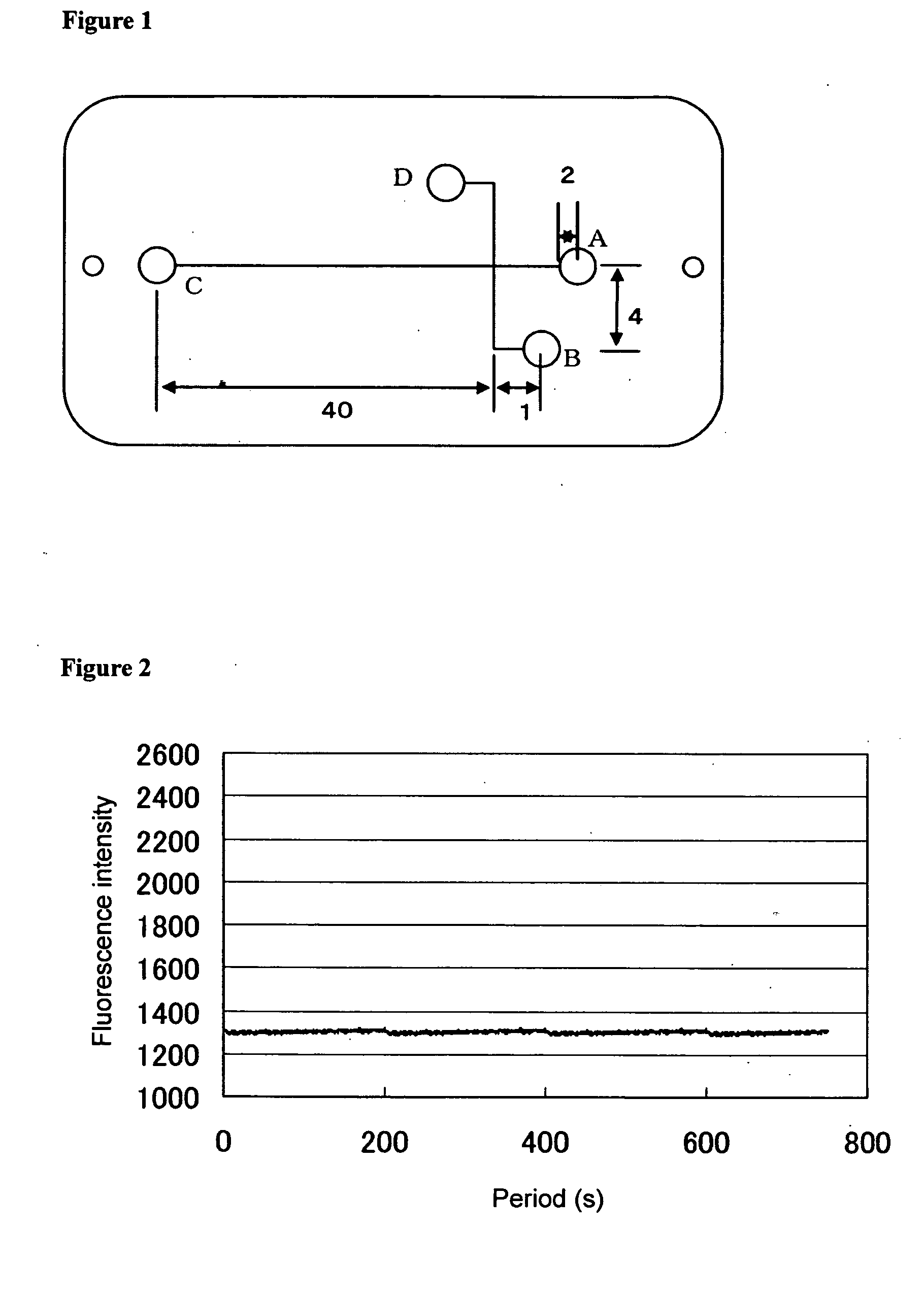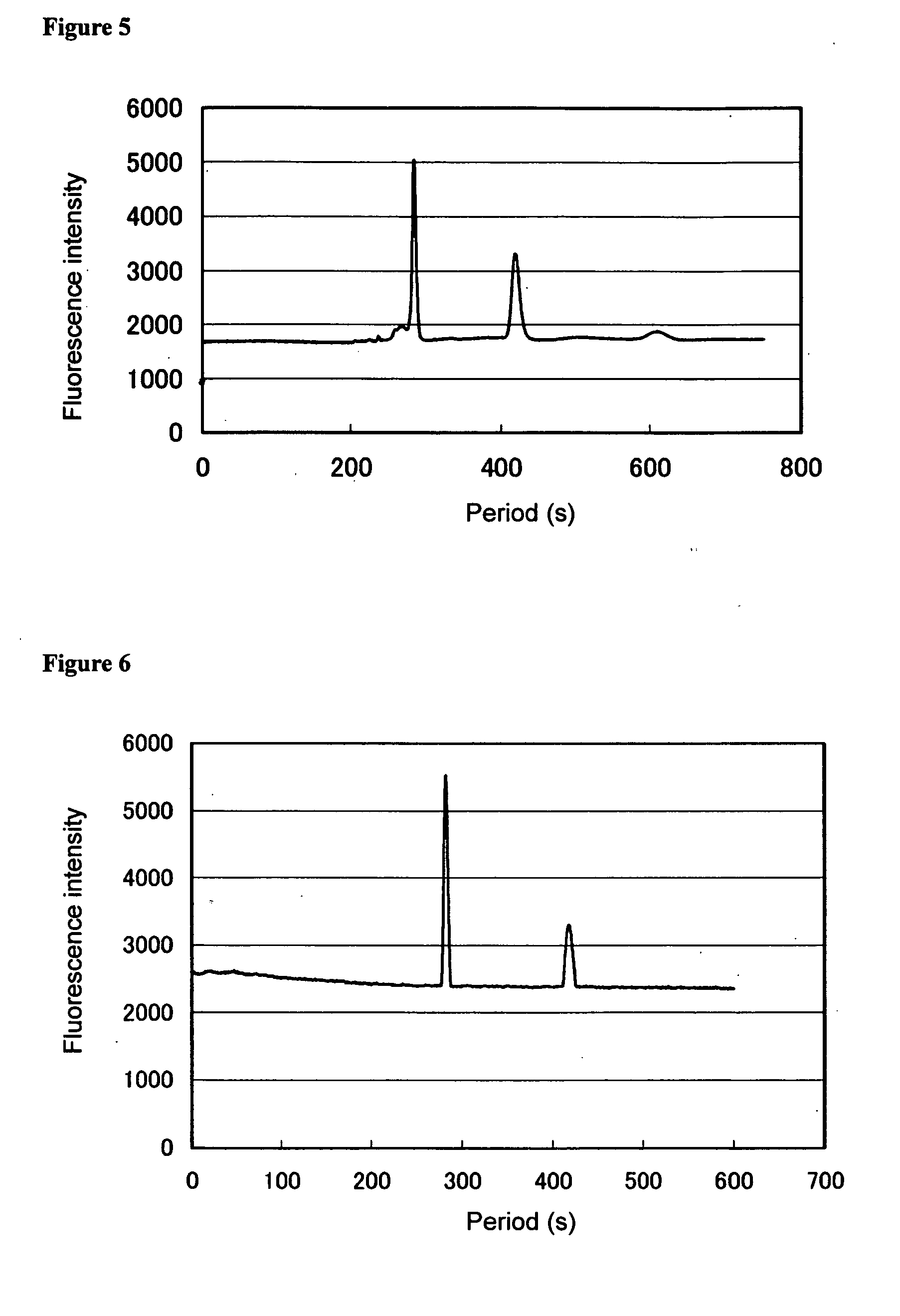Substrate for labo-on-a-chip
a technology of substrate and labo, applied in the field of labo substrate, can solve the problems of substrate not being usable for analysis, hydrophilic polymer is easily separated, and the concentration and structural change of less abundant proteins are significan
- Summary
- Abstract
- Description
- Claims
- Application Information
AI Technical Summary
Benefits of technology
Problems solved by technology
Method used
Image
Examples
example 1
[0079] A polymethyl methacrylate substrate having a size of 20×60 mm and a thickness of 0.2 mm was immersed in an aqueous solution containing a polyethylene glycol having a molecular weight of 500,000 at a concentration of 2,000 ppm. The immersed polymethyl methacrylate plate was sealed in a container, and irradiated with a gamma ray at an intensity of 2.5 kGy, allowing graft polymerization. The gamma ray-irradiated substrate was dried, and bonded to a fluorescent plate having a hole for light transmission. The bonded fluorescent plate was immersed in a diluted aqueous solution containing 10 lg / ml of FITC-labeled BSA protein and IgG protein at room temperature for 10 minutes, allowing immobilization of the proteins, and then washed with phosphate buffer (PBS) after removal of the solvent, and then, the fluorescence intensity thereof was determined.
example 2
[0086] An aqueous solution containing a polyethylene glycol having a molecular weight of 500,000 at a concentration of 2,000 ppm was filled in a microchannel of 100 μm in width ×60 μm in depth ×50 cm in length formed on a polymethacrylate substrate, and irradiated with gamma ray at an intensity of 2.5 kGy, allowing graft polymerization. After irradiation, the aqueous polyethylene glycol solution in the microchannel was removed, and washed with purified water. A solution containing E. coli-derived cell-free protein synthesis system was injected and left in a microchannel at 30° C. for 1 hour, allowing production of chloramphenicol acetyl transferase (CAT), an enzyme having a molecular weight of 26,000 that transfers the acetyl group of acetyl CoA to the 3′-hydroxyl group of chloramphenicol. The CAT protein produced in the microchannel was recovered, and quantitatively determined by ELISA in Example 2.
example 3
[0091] A polymethyl methacrylate-based electrophoretic chip having a channel of 100 μm in diameter was immersed in an aqueous solution containing a polyethylene glycol having a molecular weight of 500,000 at a concentration of 2,000 ppm. The immersed polymethyl methacrylate plate was sealed in a container, and irradiated with a gamma ray at 2.5 kGy, allowing graft polymerization. The polyethylene glycol in the channel was removed; 5% polyacrylamide (molecular weight: 600,000 to 1,000,000) solution in 0.1 M Tris-aspartic acid (pH 8) was filled; 5% polyacrylamide (molecular weight: 600,000 to 1,000,000) solution in 0.1 M Tris-aspartic acid (pH 8) was added to the A, B, and C regions shown in FIG. 3; and 0.05 M Tris-HCl (pH 8) solution of fluorescent-labeled trypsin inhibitor and fluorescent-labeled BSA containing 1% SDS was filled in the D region. An electrode was connected to each of the A, B, C, and D regions on the electrophoretic chip filled with the polyacrylamide or protein solu...
PUM
 Login to View More
Login to View More Abstract
Description
Claims
Application Information
 Login to View More
Login to View More - R&D
- Intellectual Property
- Life Sciences
- Materials
- Tech Scout
- Unparalleled Data Quality
- Higher Quality Content
- 60% Fewer Hallucinations
Browse by: Latest US Patents, China's latest patents, Technical Efficacy Thesaurus, Application Domain, Technology Topic, Popular Technical Reports.
© 2025 PatSnap. All rights reserved.Legal|Privacy policy|Modern Slavery Act Transparency Statement|Sitemap|About US| Contact US: help@patsnap.com



